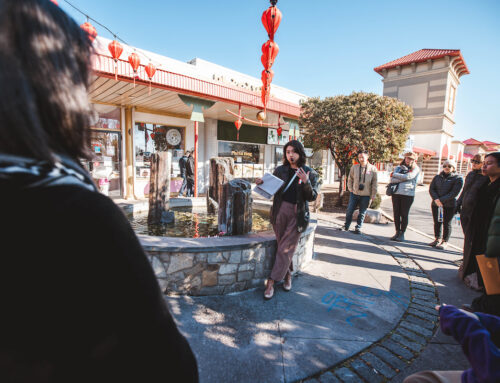Announcing Our 2022 Case Study Awards!
Twelve Grantees Will Study Anti-Displacement Efforts
The Small Business Anti-Displacement Network is thrilled to announce our 2022 case study awards! After a competitive proposal process, 12 organizations have been awarded grants to study efforts to preserve small businesses in gentrifying neighborhoods. Over the next year, awardees will meet and learn from other case study teams, receive support from SBAN experts, and present their work to the network and other stakeholders at SBAN events.
The awardees are:
Inclusive Action for the City, Los Angeles
Case study focus: The Community-Owned Real Estate (CORE) project is an effort to preserve small businesses and nonprofits through real estate acquisition and shared ownership. The case study will investigate the project’s replicability as an anti-displacement strategy, its current and potential impact on the community and small businesses, and the viability of tenant-ownership pathways.
Ventures, Seattle
Case study focus: Over the past three years, Ventures has piloted three small-business anti-displacement strategies, including commercial lease training and loans and capital access programs. The case study will evaluate the outcomes of the programs through a client-led, asset-based framework.
Gresham Redevelopment Commission, City of Gresham, Portland Metro Area
Case study focus: The Rockwood Market, located in a disinvested Portland suburb, provides micro-sized spaces for restaurants, grocers and retailers, making local entrepreneurs’ hopes of starting a business more attainable. The hall has a tenant selection committee composed of community members and offers flexible lease terms, incentive packages, and business development technical assistance.
Chinatown Community Development Center , San Francisco
Case study focus: The Feed + Fuel Chinatown project provides meals and meal vouchers to extremely low-income families living in San Francisco’s Chinatown single room occupancy buildings. These families received hot, prepared, culturally appropriate meals from local Chinatown restaurants, supporting local restaurants and keeping residents employed, and reducing residents’ use of communal kitchens during COVID-19 shutdowns.
San Francisco Heritage & University of Oregon Historic Preservation Program, San Francisco
Case study focus: This case study focuses on heritage districts and legacy business programs as anti-displacement tools to preserve culturally important sites and practices. San Francisco Heritage has gone beyond the traditional historic preservation processes to develop a strategy that helps marginalized communities in the city preserve culture-related commercial activities in place despite extreme market pressures.
Binita Mahato, Auburn University, Kolkata, India
Case study focus: With a diverse set of unregulated economic activities, including hawking and vending in public spaces, the informal sector runs most of the economy in the Global South. This case study will investigate the Hawker Sangram Committee, the largest and most powerful federation of hawkers’ unions in Kolkata, and member union the Dharmatala Street Hawker Union to understand how unionization can act as an anti-displacement strategy.
Institut de Recherche et d’Informations Socioéconomiques, Montreal, Canada
Case study focus: As with most Chinatowns in North America, Montreal’s Chinatown is subject to rising property values. This case study shows how merchants’ associations, family associations, community organizations, religious associations and others have worked together to preserve the neighborhood against real estate speculation that threatens small merchants and tenants with eviction, including through zoning changes and heritage designation.
District Bridges, Washington, D.C.
Case study focus: District Bridges is a community development nonprofit organization that serves the Lower Georgia Avenue Corridor, which has been deeply impacted by Washington, D.C.’s history of segregation and rapid gentrification. The case study will focus on their multi-main street model as one aspect of the Lower Georgia Avenue Equitable Development Plan.
The Allapattah Collaborative CDC, Miami
Case study focus: Allapattah is one of Miami’s oldest neighborhoods and a rapidly gentrifying, low-income community of color. This case study will focus on Allapattah Collaborative CDC’s Small Business Resiliency Cohort program, an effort to strengthen neighborhood small businesses by providing business model infrastructure development, navigator assistance, and personal coaching.
Latin Elephant, London Metro (Borough of Southwark)
Case study focus: In the neighborhood of Elephant and Castle in the Borough of Southwark, one of the fastest gentrifying areas in London, many racialized or migrant groups have been the target of commercial eviction. This case study will document two campaigns led by Latin Elephant to retain migrant and ethnic businesses amidst processes of gentrification.
Puerto Rican Cultural Center, Chicago
Case study focus: The Humboldt Park area is home to most of Chicago’s Puerto Rican residents. This case study will explore creation of SB 1833 in Illinois, a bill that allows designation of cultural districts across the state, and efforts to use this designation to slow down gentrification and keep small businesses in place in Humboldt Park.
Purple Line Corridor Coalition, Washington, D.C. Metro (Maryland)
Case study focus: The case study will showcase small business anti-displacement efforts along a transit line currently under construction in the Maryland suburbs of Washington, D.C. PLCC focuses on six commercial districts along the line where the majority of small business owners and patrons are immigrant, Black, or Latinx and where displacement risk is the greatest.



